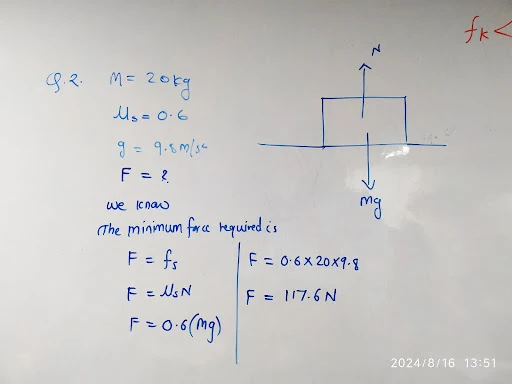Prepare for CBSE, JEE, NEET, and CET exams with this free online MCQ test on Friction (Part 1) and Newton’s Laws of Motion. Practice Physics previous-year questions (PYQs) with step-by-step solutions to strengthen your problem-solving skills and grasp core concepts effectively.
Q. 2. A 20 kg block is at rest on a horizontal surface. The coefficient of static friction between the block and the surface is 0.6. What is the minimum horizontal force required to move the block?
A. 98 N
B. 117.6 N
C. 147 N
D. 196 N
Solution
Q. 3. A 5 kg block slides down an inclined plane at an angle of 45° with a coefficient of kinetic friction of 0.3. What is the acceleration of the block?
A. 3.08 m/s²
B. 4.85 m/s²
C. 5.76 m/s²
D. 6.91 m/s²
Q. 4. A block is placed on a slope with an angle of 45°. If the coefficient of static friction is 0.7, what is the maximum mass of the block that will not slide down?
Q. 5. A 7 kg block is pulled across a horizontal surface with a force of 60 N at an angle of 30° above the horizontal. The coefficient of kinetic friction is 0.25. What is the acceleration of the block?
Options:
1. 1.5 m/s²
2. 2.0 m/s²
3. 2.5 m/s²
4. 6.0 m/s²
Solution
Q. 6. A 5 kg block is placed on the floor of a lift. The coefficient of static friction between the block and the lift is 0.4. If the lift accelerates upwards at 2 m/s², what is the maximum horizontal force that can be applied to the block without causing it to slide?
Options:
1. 23.6 N
2. 29.4 N
3. 9.2 N
4. 9.0 N
Solution
Q. 7. Consider a pulley system where a 10 kg block is connected to a 5 kg block by a rope over a frictionless pulley. The 10 kg block is on a horizontal table with a coefficient of kinetic friction of 0.4. What is the acceleration of the system?










.png)

0 Comments